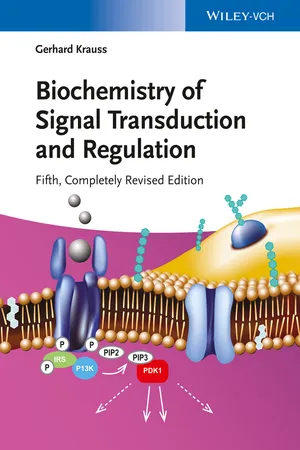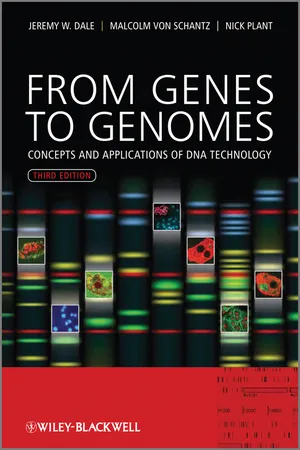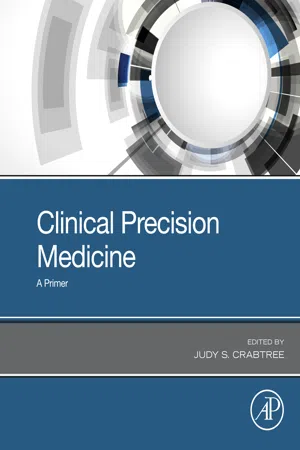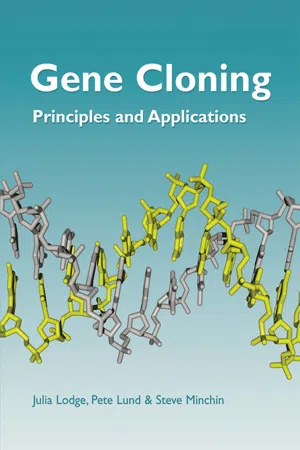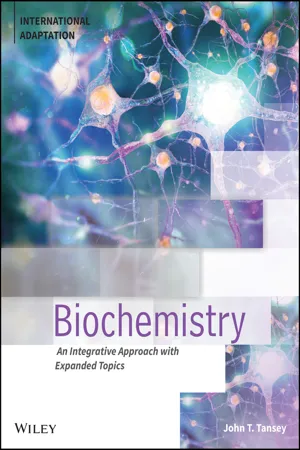Biological Sciences
Gene Expression
Gene expression refers to the process by which information from a gene is used to create functional gene products, such as proteins. It involves the transcription of the gene's DNA into RNA and the subsequent translation of RNA into proteins. Gene expression is tightly regulated and plays a crucial role in determining an organism's traits and functions.
Written by Perlego with AI-assistance
Related key terms
12 Key excerpts on "Gene Expression"
- Buddhi Prakash Jain, Shyamal K Goswami, Tapan Sharma, Buddhi Prakash Jain, Shyamal K Goswami, Tapan Sharma(Authors)
- 2022(Publication Date)
- Academic Press(Publisher)
Chapter 1: Regulation of Gene Expression in mammals
an overviewShyamal K. Goswami School of Life Sciences, Jawaharlal Nehru University, New Delhi, IndiaAbstract
The human genome is a large and complex storehouse of information that is meticulously propagated and deciphered by the macromolecular assemblies of gene regulatory proteins and RNAs. An intricate network of feed-forward and feedback interactions among these entities ensures the precise levels of Gene Expression in any cell type in a given context. Such macromolecular interactions involve simple diffusion, synergistic interactions, phase separation (in the nucleus), and kinetic regulations. Molecular biology, the subdiscipline that studies the process of Gene Expression, has also shown phenomenal growth since the discovery of the DNA structure in 1953. The title word “Gene Expression” yielded 95,691 entries in PubMed of which 7186 were reviewed articles as of January 31, 2022. Almost all other disciplines of biology viz., biochemistry, structural biology, genetics, epigenetics, developmental biology, proteomics, transcriptomics, and bioinformatics have significantly contributed toward the accumulation of such a large volume of information. Thus, although it would be a gargantuan effort to summarize such an ocean of information in a single review, I have only summarized major aspects of Gene Expression viz., the structure of core promoters, the RNA polymerases, and transcription factors that performs the synthesis of pre-mRNA, post-transcriptional processing of the pre-mRNA, small regulatory RNAs, and epigenetic regulation. Also, for further information for the readers, I have cited the recent reviews by eminent researchers for each of the topics that I have covered, albeit except citing the original pioneering discoveries. I hope this review will give the readers a platform to comprehend the essence of the excitements in the field as provided by the other authors of this book on post-transcriptional gene regulation in the context of various human diseases- Gerhard Krauss(Author)
- 2014(Publication Date)
- Wiley-VCH(Publisher)
4 The Regulation of Gene Expression4.1 The Basic Steps of Gene Expression
The transfer of genetic information from the level of the nucleic acid sequence of a gene to the level of the amino acid sequence of a protein or to the nucleotide sequence of RNA is termed Gene Expression. In eukaryotes, Gene Expression includes the following steps:- Transcription: the formation of a primary transcript, the pre-mRNA.
- Conversion of the pre-mRNA into the mature mRNA: this includes processing, splicing, and transport from the nucleus to the cytosol.
- Translation: synthesis of the protein on the ribosome.
The expression of genes follows a tissue- and cell-specific pattern, which determines the function and morphology of a cell. In addition, all development and differentiation events are characterized by a variable pattern of Gene Expression. The regulation of Gene Expression thus plays a central role in the development and function of an organism. Because of the multitude of individual processes which are involved in Gene Expression, there are many potential regulatory sites (Figure 4.1 ).Levels of regulation of eukaryotic Gene Expression.Figure 4.14.1.1 Regulation of Transcription
At the level of transcription, it can be determined whether a gene is transcribed at a given point in time. The chromatin structure plays a decisive role in this regulation, and chromatin structures exist that can effectively inhibit transcription and shut down a gene. This “silencing” of genes can be either transient or permanent, and is generally observed in development and differentiation processes. The regulated transcription of genes requires as an essential step the reorganization and modification of the chromatin, which is a prerequisite for the initiation of transcription.- eBook - ePub
Genes, Brain Function, and Behavior
What Genes Do, How They Malfunction, and Ways to Repair Damage
- Douglas Wahlsten(Author)
- 2019(Publication Date)
- Academic Press(Publisher)
Chapter 3Gene Expression
Abstract
The DNA of a gene is transcribed into an RNA molecule and then translated into a protein. The set of genes is the same in all cells in the body, but the proteins expressed are often very different, depending on the kind of cell. The expression of a gene in a cell can be studied by noting the kinds of RNA it contains or the kinds of proteins it makes. The study of Gene Expression makes it possible to know when and where each kind of gene is active in the body. Events in the environment can suppress the expression of a gene by attaching small methyl (CH3) groups to the DNA. These epigenetic marks can endure for weeks and years in one individual and play a role in memory, and they can also be passed from parent to offspring. This blurs the distinction between heredity and environment.Keywords
DNA expression array; Messenger RNA; Transcription-translation; Epigenetics; MicrobiomeAlthough almost every cell in the body has a complete set of genes, only a fraction of those genes is expressed as RNA and protein in any particular cell or kind of tissue. Gene Expression is exceedingly complex, and even today, more than 10 years after the complete human genome sequence was determined in 2006, much remains to be learned. A presentation of the New Genetics by the National Institute of General Medical Sciences described the details of Gene Expression as “murky.” Fortunately, the fine details of mechanisms of Gene Expression are not critically important for understanding later chapters.Inside and Outside the Nucleus
In order to read the information in a specific gene and transcribe it into RNA, the strands of the DNA double helix must be unwound in the vicinity of that gene. There is a promoter region at the beginning of a gene that provides a site to which the enzyme RNA polymerase can attach and start the process of transcription (Fig. 3.1A ). The promoter region does not become part of the RNA that is translated into protein. There are also enhancer - eBook - ePub
From Genes to Genomes
Concepts and Applications of DNA Technology
- Jeremy W. Dale, Malcolm von Schantz, Nicholas Plant(Authors)
- 2011(Publication Date)
- Wiley(Publisher)
6 Analysis of Gene ExpressionGene Expression can be divided into two main phases: transcription (copying DNA into RNA), and translation (production of a protein or polypeptide to the specifications of an mRNA template). For the purpose of this chapter, we will treat the polypeptide chain as the end product of Gene Expression; this ignores subsequent post-translational modification, including the folding of the polypeptide into the correct conformation for biological activity, as well as other modifications, such as phosphorylation or the specific addition of carbohydrate groups, which may modify the protein's biological activity. However, it is important to note that there are classes of genes that are transcribed into RNA, but not into proteins. These non-coding RNAs include not only the well-characterized rRNAs and tRNAs, but also the recently discovered miRNAs (microRNAs), which have an important role in gene regulation. In this chapter, we will discuss methods for the study of the products of single genes, and in Chapter 10 we will extend this discussion to the study of complex samples on a genome-wide basis.6.1 Analysing transcriptionThe first group of techniques for examining Gene Expression consists of various ways of assessing the amount of a specific transcript in a specific sample at a specific time. Other methods, described later in the chapter, are concerned with studying the transcriptional activity associated with the gene in question. Two points concerning the measurements of mRNA levels should be noted. Firstly, the amount of a specific mRNA in a cell at a given point in time is influenced not only by the level of transcriptional activity, but also by the stability of that mRNA (i.e., it reflects the balance between transcription and degradation). Therefore, a gene that is transcribed at a low level but gives rise to a stable mRNA may result in a greater amount of mRNA than a transcriptionally more active gene that produces an unstable message. Secondly, the amount of mRNA present does not necessarily correlate with the amount of protein made. This is most obvious with bacterial cells, where a single polycistronic message may be translated into many different polypeptides; although these are all translated from the same mRNA template, the levels of the different proteins made can be widely different – translation efficiencies can vary considerably. - eBook - ePub
Clinical Precision Medicine
A Primer
- Judy S. Crabtree(Author)
- 2019(Publication Date)
- Academic Press(Publisher)
Chapter 2Molecular genetics—the basics of Gene Expression
Andrew D. Hollenbach, PhD Co-director, Basic Science Curriculum, School of Medicine, Professor, Department of Genetics, Louisiana State University Health Sciences Center, New Orleans, LA, United StatesAbstract
Human beings are complex biological machines and as such require a finely tuned regulation of Gene Expression. Mutations in genes or alterations in regulatory sequences may alter normal expression and consequently contribute to the development of disease. Therefore, it is important to understand the basics of Gene Expression along with the mechanisms by which this expression may be regulated to fully understand the development of disease and how these mutations may affect treatment options. In this chapter, we provide a discussion of the basic mechanisms of Gene Expression, including replication, DNA repair, transcription, RNA processing, and translation. We also discuss different aspects of gene regulation including pre- and posttranscriptional mechanisms. Finally, we describe how individual mutations may alter Gene Expression and how understanding the basic mechanism of how these mutations alter Gene Expression may be important for the prescribing of precise therapies for individual patients.Keywords
Gene Expression; Gene regulation; Mutations; Mutations and disease; Precision medicine; Replication; Transcription; Translation-
Replication
- DNA repair
- Transcription
- RNA processing
- Protein translation
-
Regulation of Gene Expression
- Pretranscriptional gene regulation
- Posttranscriptional regulation
- The role of mutations in altering Gene Expression and protein function
- Mutations, Gene Expression, and precision medicine
A complex network of proteins, enzymes, and regulatory molecules orchestrates the expression of proteins required for the biological processes important for the proper functioning of humans. An equally complex network of regulation controls Gene Expression or the process by which the blueprint information stored in an individual's DNA is converted into these functional proteins. Because of this complexity, small variations or alterations at any step in the conversion of DNA into protein may have significant outcomes that contribute to the development of the diseased state. More importantly, although individuals may have what appears to be an identical pathological presentation of a disease, many times the underlying genetic alterations that led to the development of this disease may be different, which could greatly affect their responses to therapy. Therefore, it is important to understand the molecular genetics of Gene Expression to better understand how the treatments used in the clinic are based solidly in the molecular mechanisms of the disease. - eBook - ePub
- James C. Blackstock(Author)
- 2014(Publication Date)
- Butterworth-Heinemann(Publisher)
CHAPTER 17Gene Expression
Publisher Summary
This chapter presents the concept of Gene Expression. The concept of the central dogma of molecular biology, formulated in the late 1950s by Francis Crick may be summarized as DNA (deoxyribonucleic acid) →RNA (ribonucleic acid) →protein. Transcription is the process in which RNA is synthesized by enzymes called DNA-directed RNA polymerases. These enzymes use ribonucleoside triphosphates as substrates and DNA as a template. Specific base sequences signal the termination of transcription. Transcription produces RNA molecules. Translation involves two compartments: the cytosol in which individual amino acids are enzymically attached to their specific tRNAs by amino-acid-tRNA ligases and the ribosomes in which the amino acids are correctly positioned according to the base sequence of a mRNA template and polymerized into polypeptide chains. As there are four major bases in mRNA, 43 different codons are possible. The 64 triplets constitute the genetic code. The genetic code applies to prokaryotes and eukaryotic nuclear and chloroplast mRNAs but not to mitochondrial mRNAs. Therefore, the genetic code is quasi-universal.17.1 The central dogma
The concept of the central dogma of molecular biology (Section 1.6 ), formulated in the late 1950s by Francis Crick may be summarized as DNA (deoxyribonucleic acid) → RNA (ribonucleic acid) → protein.In all living organisms, nuclear DNA serves as the reservoir of genetic information which is expressed in terms of the structure of proteins manufactured by the cell. The base sequence of the DNA determines the amino acid sequence of proteins which are responsible for all aspects of cellular function. Because of cellular organization, synthesis of protein from the DNA blueprint occurs in two stages: transcription, i.e. the synthesis of a messenger RNA molecule of a structure complementary to the structure of DNA so that the genetic information is transferred to mRNA, and upon delivery of the message to the cytosol, its translation into protein. - eBook - ePub
- Tom Strachan, Anneke Lucassen(Authors)
- 2022(Publication Date)
- CRC Press(Publisher)
6Principles of gene regulation and epigeneticsDOI: 10.1201/b22853-6All our cells develop ultimately from the zygote. Each nucleated cell in a person contains the same set of genes. However, only a subset of the genes in a cell are expressed to make functional end products, and that subset varies according to the type of cell. The global Gene Expression pattern of a cell dictates the form of a cell, how it behaves, and ultimately its identity—whether it will be a hepatocyte, for example, or a macrophage, or a sperm cell.In Chapter 2 we outlined the basic details of Gene Expression. Here, we are concerned with how the expression of genes is regulated. Different levels of gene regulation affect the production or stability of gene products: transcription, post-transcriptional processing (to make final mRNA or noncoding RNA products), translation of mRNA, post-translational modification, folding of protein products, incorporation into a multisubunit functional molecule, and degradation of gene products.We explore aspects of mRNA degradation and protein folding in Chapter 7 . Here we mostly deal with gene regulation at the levels of transcription, post-transcriptional processing, and translation. Complex networks of interacting regulatory nucleotide sequences and proteins are involved.The two fundamental types of gene regulation
All the cells in our body originate by cell division ultimately from one cell, the fertilized egg cell. Given that in each person the nucleated cells all contain the same DNA molecules, readers might reasonably wonder how we could ever come to have different cell types with distinct Gene Expression patterns. However, it is not just the sequence of nucleotides in DNA that determines Gene Expression. Chromatin structure is also crucially important, and Gene Expression is regulated at two fundamental levels listed below, one of which is not genetic.- Genetic regulation. Here control of Gene Expression is dependent
- eBook - ePub
Plant Biotechnology and Genetics
Principles, Techniques, and Applications
- C. Neal Stewart, C. Neal Stewart(Authors)
- 2016(Publication Date)
- Wiley(Publisher)
CHAPTER 6 Molecular Genetics of Gene Expression MARIA GALLOMolecular Biosciences and Bioengineering Department, ā, Honolulu, HawaiiALISON K. FLYNNVeterinary Medical Center, University of Florida, Gainesville, Florida6.0. CHAPTER SUMMARY AND OBJECTIVES
6.0.1. Summary
Along the information pipeline from DNA (a gene) to the production of a protein, there are many steps where Gene Expression can be controlled. In eukaryotes, such as plants, transcriptional control is considered the major form of gene regulation. Because of its importance, transcriptional regulation has been the best studied and probably the most manipulated. However, it is becoming clearer each day that posttranscriptional mechanisms of gene regulation are critical because levels of transcription are not always well correlated with functional protein levels. Additionally, as the area of proteomics advances, and as we move from genetically engineering plants to improve their performance or enhance their utility in a traditional agricultural setting, to using plants as biofactories to produce proteins, posttranslational regulation will gain in importance.6.0.2. Discussion Questions
- What are the differences between DNA and RNA?
- Describe the main parts of a gene and their functions.
- How important are cis-regulatory elements and trans-acting factors in gene regulation?
- What are the control points that can regulate Gene Expression?
6.1. THE GENE
6.1.1. DNA Coding for a Protein via the Gene
From Chapter 2 , we saw that there are several definitions of a gene. In this chapter, gene means a specific segment of DNA, including its regulatory regions, that code for a protein. In this chapter, we describe the central dogma of genetics, which involves information flow from DNA to RNA via transcription in the nucleus, followed by RNA transport into the cytoplasm, where it is translated into protein. Let’s first look at DNA. What exactly is DNA? DNA, or deoxyribonucleic acid, is simply a chemical, a double-stranded, helical polynucleotide, to be specific. However, in the proper biological context, this chemical determines such traits as the color of a petunia petal, the scent of a citrus blossom, the sweetness of a corn kernel, the strength of a cotton fiber, and the yield of a wheat head in the face of biotic and abiotic stress. The majority of a plant’s DNA is found within the nucleus of each cell. Specific segments of the nuclear DNA, called genes - eBook - ePub
- Julia Lodge, Peter Lund, Steve Minchin(Authors)
- 2007(Publication Date)
- Taylor & Francis(Publisher)
Section 10.5 .11.6 Global Studies of Gene Expression
Until recently most scientists interested in the regulation of Gene Expression would study a single gene or operon. However, with the advent of genomics and the availability of whole genome sequences, techniques have been developed which allow us to study the regulation of expression of all, or a very large number of, genes from an organism in a single experiment. These are very powerful techniques that can provide a large amount of information including an insight into the function of genes of unknown function. We will look at techniques that allow us to monitor the level of RNA transcription and protein expression.Transcriptomics
Transcriptomics is a term that has been coined to describe the study of global Gene Expression at the level of RNA. The transcriptome is the complete set of RNA transcripts produced by a cell or organism at any one time. Since different genes are being transcribed at different times and in different cell types, the transcriptome is very dynamic (unlike the genome of an organism which is always the same). We discussed northern analysis in Section 11.3 as a method to determine the level of an RNA transcript and how this technique is used to study a single gene. During northern analysis you immobilize your RNA sample on a nylon or nitrocellulose filter; you then incubate a labeled probe with the filter, and the level of probe hybridization gives you a readout of the level of RNA for that gene in the original sample. Transcriptomics exploits a technique that is essentially “reverse” northern analysis (Figure 11.9 ). In this technique, rather than immobilizing the RNA sample, the DNA probe is immobilized, for example applied to a nylon filter; the DNA probe is not labeled. RNA is then isolated from your sample cells and labeled cDNA prepared representing all the RNA in the sample; this is then incubated with the immobilized DNA probe. The level of probe hybridization gives a readout of the level of RNA for the gene represented by the probe. If you immobilize several probes on the same nylon filter you can determine the RNA levels for each gene, based on the level of hybridization to each probe, since the labeled RNA will only hybridize to its complementary probe on the membrane. It is possible to array thousands of probes onto a single nylon membrane just a few centimeters square, for example a commercial array that is readily available contains probes for nearly 3000 cancer-related human genes on an 8 cm × 24 cm nylon membrane. So by using this array you are in essence doing northern analysis of nearly 3000 genes in a single experiment. Rather than using nylon membranes to immobilize your probe it is possible to use glass slides. The glass slides are high quality microscope slides that have been chemically treated so that they can bind the DNA probes. The glass slides have some advantages, the main one being that they allow the detection of fluorescently labeled cDNA. This permits independent detection of two samples because each sample can be labeled with different fluorescent dyes (Box 5.3 - eBook - ePub
- Matthew Avison(Author)
- 2008(Publication Date)
- Taylor & Francis(Publisher)
Anderson and Seilhamer, 1997). Many people forget this, and because transcriptomics is methodologically more straightforward (and perhaps more easily automated) this is the predominant approach for measurement of global Gene Expression. Beware! For a gene to be truly expressed, a functionally active protein must be produced. Because it is often not possible to measure the amount of a particular protein in a cell, for example if it does not have an easily assayable activity, or if you do not have an antibody suitable for quantification of the protein, it is common to check for differential translation of a transcript flagged up by a transcriptomics experiment by fusing the gene to a reporter gene. These either encode an enzyme that is easily assayable, or a peptide tag whose concentration can be measured using a commercially available antibody. This is generally satisfactory, but be aware that the use of reporter genes is an artificial situation as set out in Chapter 6. There are many other problems of biological and experimental variability particular to the individual methods for measuring Gene Expression, and these will be described in the various chapters of this book. The remainder of this chapter is aimed at explaining why the transcriptome and proteome are both so dynamic, by providing a brief overview of the myriad regulatory and mechanistic pathways involved in controlling the expression of a gene. This is a long way from a thorough explanation of Gene Expression and its control, however, and the reader should look elsewhere for more detailed examples that may be pertinent to their particular field of research. 1.2 An overview of the mechanics of transcription Protein/DNA interactions Transcription, and its control, is all about protein/DNA interactions - eBook - ePub
- Robert A. Meyers(Author)
- 2014(Publication Date)
- Wiley-Blackwell(Publisher)
run-off transcription . In this case, the nuclei are first isolated from the cells and then incubated with radiolabeled nucleoside triphosphates. Under suitable conditions, unfinished transcripts will be completed, but no new transcripts will be synthesized; consequently, the RNA that is labeled by using this method will have been derived from those genes that started transcription at the time the nuclei were isolated. Subsequently, when the labeled RNA is used to probe DNA from a clone of genes under investigation, an absence of hybridization between the labeled RNA and the cloned DNA indicates that the DNA was not transcribed in the tissue. The use of this technique to examine several genes has led to the realization that an absence of Gene Expression does, indeed, result from an absence of transcription [27].Regulation of Gene Expression. Gene regulation may take place in a gene-specific manner at any of the several sequential steps. However, there are five potential control steps.Fig. 6Nowadays, DNA microarray technology – which is more commonly known as “gene chip technology ” – is also used widely to identify the presence of complementary sequences of DNA. In fact, microarray technology can be regarded very much as a modern-day ‘genetic revolution,’ and comparable to the development of microprocessors in the computer revolution of 30 years ago. Today, with the advent of microarray technology, the task of screening genetic information has become an automatic routine that exploits the tendency for a molecule, that is carrying a template for synthesizing mRNA and protein, to bind to the very DNA that produces it. Currently, microarrays incorporate many thousands of probes, each of which is imbued with a different nucleic acid from known and unknown genes, to bind with mRNA. Subsequently, the resulting bonded molecules will fluoresce under different colors of laser light, thus demonstrating which complementary sequence is present. In this way, these microarrays can be used to measure the incidence of genes and their expression.More recently, following the determination of the human genome sequence, the importance of the single nucleotide polymorphism (SNP) has also been realized. The SNPs represent minor variations in DNA that define the differences that occur among people, that may predispose a person to disease, and that may influence a patient's response to a drug. Consequently, with the genetic make-up of humankind now broadly known, it is possible to create microarrays that are capable of targeting individual SNP variations, and thereby to make much greater comparisons across the genome. Taken together, the results of these studies may help to identify the roots of many diseases, especially when combined with specific software that has been developed to design microarrays incorporating very large numbers of probes [28]. - eBook - ePub
Biochemistry
An Integrative Approach with Expanded Topics
- John T. Tansey(Author)
- 2022(Publication Date)
- Wiley(Publisher)
Condensins are proteins that have a similar structure to cohesins in that they contain a pair of SMC proteins (2 and 4) and form a ring in concert with other proteins. Condensin rings appear to contain five members, although the identity of the other proteins is unclear. There are two different classes of condensin complexes, at least one of which contains a cyclin-dependent kinase (CDK), and another interacts with topoisomerase II. The condensins are all involved in sister-chromatid separation during anaphase.17.3.3 Epigenetic gene regulation can affect expression by modifying histones or DNAGenetics is the study of heritable traits and is often taken to mean the study of genes. However, environmental factors are now known to also affect the expression of those genes. The study of modifications that affect Gene Expression but not DNA sequence is termed epigenetics .Such modifications may occur over the course of an organism’s development. One example is the differentiation of cells as an organism develops from pluripotent stem cells (able to differentiate into any of the cells of the organism) to totipotent cells (those able to differentiate into a limited number of cell types) to terminally differentiated cells (those unable to differentiate from one cell type to another). Modifications in Gene Expression may also occur in response to environmental stress. For example, survivors of the Dutch famine of 1944 were found to have increased risk of obesity, type 2 diabetes, and cardiovascular disease. Later research showed that the children and even grandchildren of women who survived the famine also suffered from these disorders at a higher rate. This finding suggests that the susceptibility to these conditions that resulted from experiencing famine was somehow passed down through these women’s genes. A final example is when identical twins or congenic animals look or behave differently owing to environmental effects, despite having identical DNA. Although their genes are identical, expression of those genes has been affected by the individuals’ environment and life experiences.Two ways that cells can regulate Gene Expression are modifications to histones or to DNA.Post-translational histone modifications Cells can control Gene Expression by regulating histone–DNA interactions to make the DNA more or less accessible to transcription factors and RNA polymerase. Histones are enriched in basic residues: arginine; histidine; and, in particular, lysine. The positively charged histones interact with the negatively charged DNA through coulombic interactions (analogous to a salt bridge in a protein) and other weak interactions; thus, hydrogen bonding occurs between the histones and DNA, dipoles from the alpha helices of the histones interact with the DNA helix, and there are hydrophobic-effect interactions between the members of the complex. Any change in histone–DNA interactions has the potential to affect gene transcription. Even relatively minor modifications (e.g., a phosphorylation) can radically change the function of a protein, and numerous modifications of histones can occur (Table 17.4 and Figure 17.15
Index pages curate the most relevant extracts from our library of academic textbooks. They’ve been created using an in-house natural language model (NLM), each adding context and meaning to key research topics.

